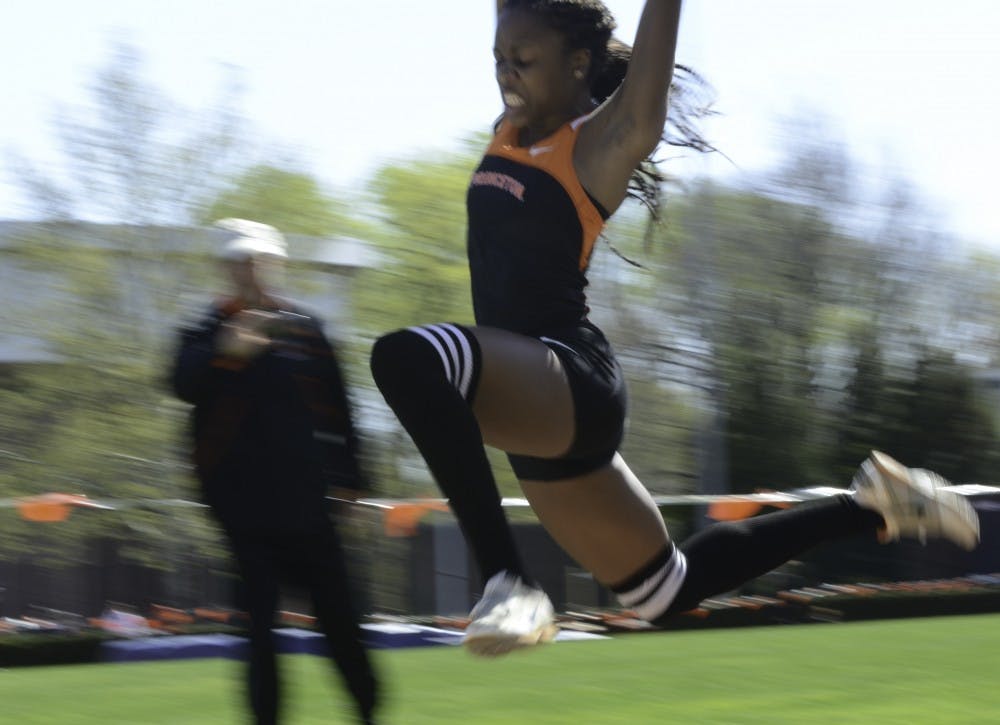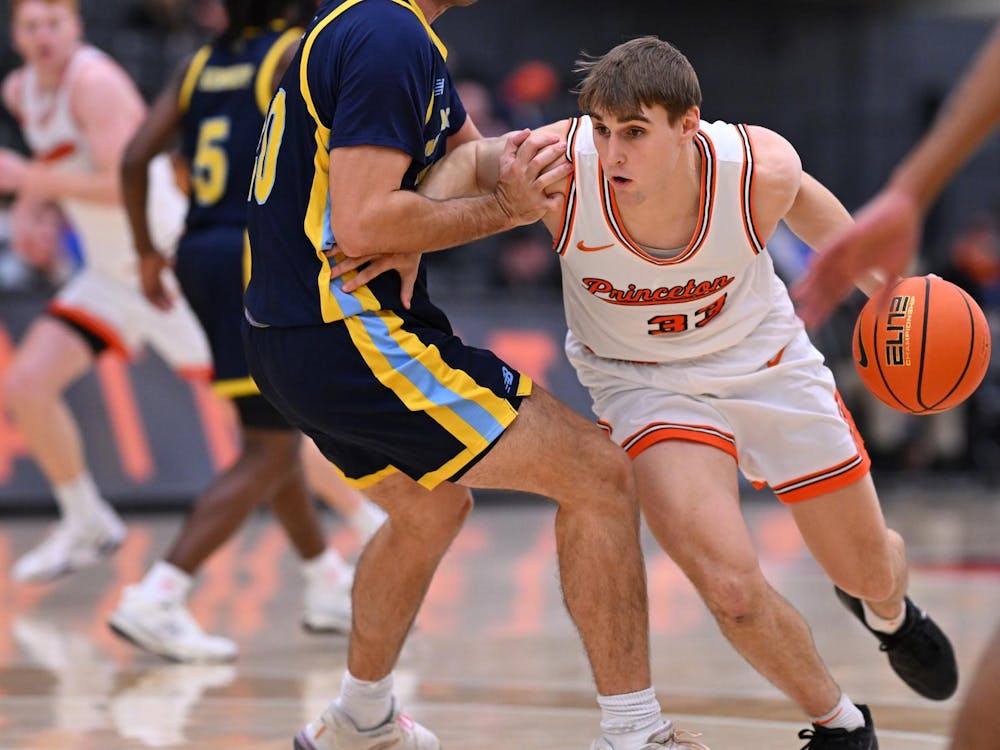Men’s team will have to overcome strong Cornell squad to achieve third straight outdoor crown
On a Sunday afternoon last May, Princeton men’s outdoor track and field dominated the Ivy League, including chief rival Cornell. This year they hope to do it again.
“Our goal is always to win,” said head coach Fred Samara. “It will be a big challenge. Cornell is a lot stronger this year than last year, but we’ll see how it pans out.”
Co-captains senior Tom Hopkins and junior Scott Rushton echo his sentiment. “We’re playing to win here,” Rushton says.
Rushton notes that a heartbreaking one-point loss to Cornell during the indoor season Ivy League championship last winter has motivated the team since then, both for last year’s outdoor championship meet and during training this fall and winter. “Cornell won [the indoor Ivy League championship] last year, and this year that’s motivated us to put a lot of work in in the fall. We lost by a point last year, so now we really know that every point counts,” he says.
Hopkins adds that the team hopes to send as many men as possible to nationals. “While winning both [the indoor and outdoor] HEPS Meets is the ultimate goal, there are several athletes on the team with national aspirations. A lot of us are right on the “bubble” of qualifying for the meet (top 16 in the nation per event), so we’re all crossing our fingers for key performances at our conference meet-up at Dartmouth,” he explains.
The team graduated some exceptional seniors last year, including Peter Callahan, Russell Dinkins and Austin Holliman of the NCAA national championship-winning distance medley squad and outdoor Ivy League 10,000m and 5,000m champion Michael Franklin. However, with continued strong performances from returning team members, including several 2013 NCAA championship competitors like Hopkins, senior distance runner Chris Bendtsen and junior sprinter Dan McCord, as well as the addition of 16 freshmen, the team is prepared to take on whatever challenges the season may bring.
“We’re doing very, very well. We have one of our strongest teams ever. I’m very proud of the team so far and what they’ve done,” says Samara.

Currently, the track team is most of the way through its indoor season and is less than two weeks away from the HEPS meet, which determines the indoor Ivy League champions. Some highlights of the indoor season so far include this Saturday’s domination over Harvard and Yale, which marked the 23rd consecutive victory for Princeton at the Harvard-Yale-Princeton meet, and an especially strong individual performance by senior Michael Williams at the Boston University Valentine Invitational in becoming the fourth-ever Princetonian to break a four-minute mile.
However, Samara stresses that, while important, individual successes are much more valuable when placed in the team context. “We have 36 guys. We really need to be strong across the board. We have a couple of guys who are having really exceptional seasons right now, but track is a team sport. We’re only as strong as our weakest link.”
Samara, Hopkins and Rushton have identified a few challenges the team will face in the upcoming spring season. Hopkins notes that in the past 10 years, the Ivy League has set an increasingly high standard for tough competition both internally and nationally. “Ten years ago, conferences like the SEC and the Big Ten would consider the Ivies as noncompetitive at their level. Five years ago they’d view us as underdogs on the national stage. Nowadays, they just give us a curt nod. With this in mind, I believe that the biggest challenge that we will face in the spring season, and in two weeks at the conference meet, will be surpassing the bar that the rest of the league has helped set in nearly every event,” he says.
Rushton feels that Cornell will provide some of the toughest competition yet, and Samara agrees. “Cornell has been probably our biggest challenge for the past 10 years,” he said. He credits part of Cornell’s success to the sheer number of team members, which far surpasses that of Princeton. “If [Cornell] gets somebody hurt, they can replace them with somebody.” What Princeton lacks in numbers it must make up for by maintaining athletes’ health as best as possible.

“The secret of being a good coach and having a good program is being able to develop the athletes and keep them healthy all year, because our season is the longest season,” notes Samara. “It’s challenging for both athletes and coaches.”
Despite these challenges, the team is looking forward to returning outdoors for the spring season. When asked about what he was most excited for, Hopkins replied, “First, running outside. Second, running half as many laps (makes a huge psychological difference).* Third, not running inside.” He and Rushton also said that they are looking forward to watching their teammates who excel outdoors perform at their best and are also looking forward to the spring break Florida training trip that kicks off the spring season.
*The indoor track is 200 meters around while the outdoor track is 400.
Women’s Track & Field hopes for Ivy championship this spring
Last year, Princeton women’s track and field was edged out by Harvard, coming in fourth at the HEPS IvyLeague championship meet. This upcoming season, they hope to beat the competition entirely and winthe title.
“I know that our team has the capability of winning HEPS, so our goals are just being healthy and gettingour training up to the level we need to be at,” says senior co-captain Imani Oliver, returning HEPS triple-jump champion, a 2013 NCAA championship competitor and Princeton’s triple-jump record-holder. Sheadds, “Our goal would be having everyone do their personal best.”
They may have a challenging road ahead. Recently, Princeton lost to Harvard at the H-Y-P meet onSaturday, Feb. 15. Since last spring, they have graduated eight-time pole vault Ivy League championTory Worthen, 800m Ivy League champion Greta Feldman, third-place steeplechase competitor MelNewberry and 10,000m runner Abby Levene. Also missing from this year’s roster is junior Cecilia Barowski,who won the 400m at the HEPS meet as a sophomore last year.
However, the team remains strong with top-notch athletes such as sophomore Julia Ratcliffe, previously oneof the top junior hammer-throwers in the world. Other athletes with promising seasons include senior javelin-thrower Ashley Vandolah, sophomore discus-thrower Brielle Rowe, senior 10K runner Marisa Cummings andsteeplechasers senior Clare Gallagher and junior Emily de la Bruyere. Freshman Megan Curham is also expected tomake a splash in the 10,000m race this spring.
“We’re looking to get these kids to nationals,” says head coach Peter Farrell.
Currently, the track team is over halfway through their indoor season and is less than two weeks awayfrom the HEPS meet, which determines the indoor Ivy League champions. “It’s an interesting time rightnow. We’re a little under two weeks away from the Ivy Championship for the indoor season. We’ll lookat how that week goes and hopefully use it as a springboard for the outdoor season,” says senior co-captain and star mid-distance runner Molly Higgins. She adds, “I hope the freshmen can gain experiencewith big meets at HEPS and can apply that experience to outdoor competition.”
Farrell and the captains have identified several challenges that the team will face in the upcoming springseason. “The biggest challenge is always trying to beat your personal best, and stepping up trainingis always going to be harder. It can be a daunting task,” says Oliver. Higgins provides an additionalperspective, identifying capitalizing on a winning strategy as one of the more difficult tasks ahead. “Wedon’t have as many luminaries this year (people who would be winning individual races), so a lot of HEPSwill come down to the smaller points: people stepping up and getting fifthplace, people stepping up andgetting thirdplace. It’s just a matter of trying to get points anywhere you can get them,” she says.
Above all, Farrell feels that maintaining his athletes’ health is the top concern. “Keeping people healthyis really the charm because all the girls run cross country, indoors and outdoors, and that’s a lot. Threeseasons is difficult.”
Even with these challenges ahead, the team is excited to move back outdoors. “A new season is alwaysexciting,” says Farrell. He continues, “I think people are made to compete outdoors. I prefer it overindoors and I look forward to getting outside.” Higgins agrees, also observing that the team tends to bestronger outdoors.
Both captains are looking forward to the spring training trip and their final season with Princetonwomen’s track. “It’s my last season with the team, and I know I’ll never have a team like I have here. I’mexcited to share more experiences and have fun with these girls,” says Oliver. “I really love them.”








